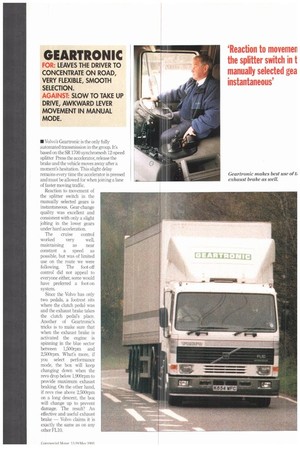GEARBOX TEST
Page 44

Page 45

If you've noticed an error in this article please click here to report it so we can fix it.
• Renault also uses a combination of visual display and lever control. The lever is a joystick moving forwards, backwards and sideways. There's also a rotary emergency switch for use if the system fails. This enables the driver to select first or reverse to manoeuvre the vehicle.
The driver can opt either to drive changing manually, or accept the system's recommendations. Driving manually is the same as with EPS, push the lever forward to change up and pull it back to change down. Otherwise it has two driving modes — economy and power. The default setting is economy, but pushing the lever to the left changes the selected mode. Crawler can be selected by holding in the red button on the front of the lever and pushing it forward, but this can be selected only when stationary. Similarly, reverse is selected by holding in the red button and pulling the lever back.
There's a black button on the right-hand side of the lever for the splitter. To split any gear in the 18-speed box, the button must be held in and the lever pushed forward for high split or back for low. The split is indicated on the right-hand side of the display.
SEQUENCE
lb drive using the system's recommended sequence of gears, the driver just has to move the lever to D and press the clutch to accept the starting gear (always first). The righthand side of the dashboard display will show the next recommended gear and all the driver has to do each time is press the clutch to accept it. When the clutch is pressed, a bleep sounds to indicate that the gear has been engaged and that the pedal can be released.
Our test vehicle chose to take whole gears from one to seven and split eight. This prompted at least one of our testers to intervene and split some of the higher gears. In his words, "This is not the easiest of processes, because the only indication if you are in high or low split is a small character on the LED display —Mercedes' toggle switch is better. Furthermore, it takes two movements on the lever and a clutch depression to complete the manoeuvre."
On the other hand, approaches to roundabouts were relatively straightforward. All you have to do is leave the Renault in its chosen gear until you can filter in and press the clutch. The system will select the right gear — more quickly than Geartronic, some of us thought. With enough engine revs it can also be enticed to block change. It was the quality of change which got approval from another tester: "While it can seem a little long at times to the more impatient of us, it is mostly quite sure and slick."
As mentioned earlier, we did experience some problems with the system. Our troubles were mostly evident on up changes between fourth and fifth. The adjustment of the mechanical linkage was blamed as it travels farther to overcome the detent protecting the range change.
If driven for longer over a much varied route our impressions may have improved slightly but that bleep can become a little wearing. A more pleasing tone or an indicator light might be preferable.
II Volvo's Geartroilic is the only fully automated transmission in the group. It's based on the SR 1700 synchromesh 12-speed splitter Press the accelerator, release the brake and the vehicle moves away after a moment's hesitation. This slight delay remains every time the accelerator is pressed and must be allowed for when joining a lane of faster moving traffic.
Reaction to movement of the splitter switch in the manually selected gears is instantaneous. Gear-change quality was excellent and consistent with only a slight jolting in the lower gears under hard acceleration.
The cruise control worked very well, maintaining as near constant a speed as possible, but was of limited use on the route we were following. The foot-off control did not appeal to everyone either, some would have preferred a foot-on system.
Since the Volvo has only two pedals, a footrest sits where the clutch pedal was and the exhaust brake takes the clutch pedal's place. Another of Geartronic's nicks is to make sure that when the exhaust brake is activated the engine is spinning in the blue sector between 1,500rpm and 2,500rpm. What's more, if you select performance mode, the box will keep changing down when the revs drop below 1,900rpm to provide maximum exhaust braking. On the other hand, if revs rise above 2,500rpm on a long descent, the box will change up to prevent damage. The result? An effective and useful exhaust brake — Volvo claims it is exactly the same as on any other FL10.
































































































































